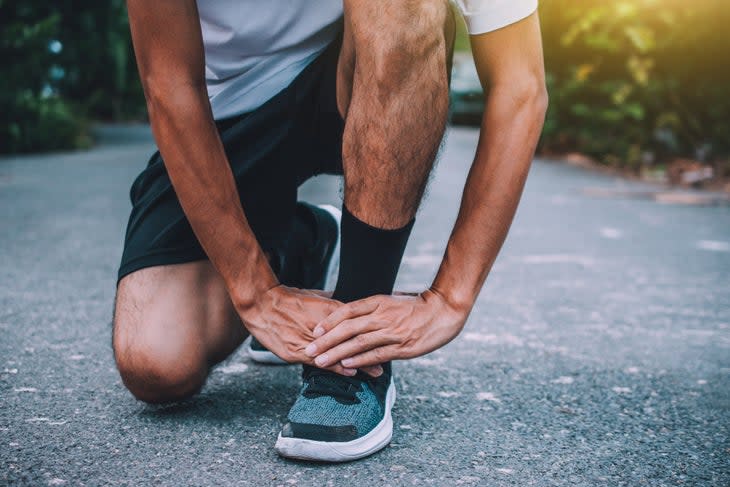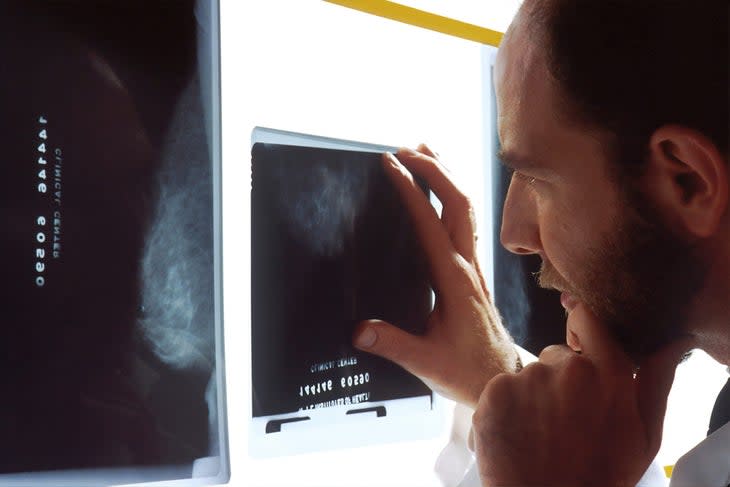The Science About Tending to Tendon Health
Trail Runner
Tendon injuries (tendinopathies) are the most common injury type among trail runners. In fact, the incidence or "rate of occurrence" of Achilles tendon pain is 10 times more likely in runners than those of the same age who don't run. This is even more the case with trail runners who incorporate significant vertical gain and loss into their training. So, what is causing that nagging tendon pain and what can you do about it?
Here's the good news: Often, with the right physical therapist and management, this doesn't always mean you have to stop running. (Whew.)
Trail running can be one of the most high-impact forms of body movement - uneven terrain, long distances, climbing, and descending. Here, force can be disproportionately placed upon the lower legs and ankles, making them susceptible to overload and, consequently, tendon injury.
What are tendons, and what do they do?
A tendon is a cord of flexible tissue - think of it like a rope. We have 600 + muscle tendons in our body, but some are more commonly known than others: the Achilles tendons (the largest in the body), the patellar tendons, and the gluteal tendons are some of the most-worked tendons in runners.
The role of a tendon, simply put, is to attach a muscle to a bone. Tendons allow the contracting or squeezing muscle to move the bone to which it's attached.
We literally wouldn't be anywhere without them.
Therefore, tendons are made up of connective tissue that is more dense and stiff than muscle tissue. As a result, they have higher resistance to breaking under tension (tensile strength). According to the American Orthopedic Institute, your Achilles tendon can take more than 1,000 pounds of force. Research shows that certain tendon fibers are stronger than steel. Our tendons absorb a portion of the force our muscles take when we run or jump and use the muscles around the tendon.

Tendinopathy, Tendonitis, Tendinosis?
In the medical world, tendon issues are generally called tendinopathies, which is an umbrella term to describe conditions "characterized by a combination of pain, swelling, and impaired performance." However, you may have heard the more commonly known terms: tendonitis and tendinosis.
So, what's the difference?
Tendonitis is a painful tendon that shows signs of inflammation in the structure. The only way to truly diagnose tendonitis is with an MRI to look at the tissues for inflammation. Tendinosis is a painful tendon that has signs of collagen degeneration due to overuse.
Multiple research studies show when tendon biopsies are taken at surgery, often there are no inflammatory cells present. The conclusion is that not every painful tendon is inflamed, and not every inflamed tendon is painful.
RELATED: Shin Splits? Ankle Pain? Here’s How To Remedy Common Running Ailments.
Here are Four Common Signs of a Tendinopathy:
In early stages, pain is usually sharper and more localized, with the ache coming on after a couple weeks.
Increasing pain that is commonly described as a dull ache at the site of the tendon, especially when moving the painful limb or joint.
General tenderness.
Morning stiffness that gradually eases with movement.
How Do You Get a Tendon Injury?
Often these symptoms come with the understanding that there has been an increase in activity, and most commonly, the pain is load-related.
The exact cause of every tendinopathy is obviously unclear, and there are sometimes genetic and environmental components, but research consensus is that most tendon injuries are mostly due to overuse.
Putting more force on a tendon than it can handle in a given time period leads to poor tendon repair and makes the tendon more likely to get micro-tears, degenerate, or become painful. Overload can look like: increased frequency, distance, pace, or speed of runs, or dramatic change in terrain.
Okay, So I Have Tendinopathy. What Can I Do?
At-Home Remedies:
A general rule of thumb, when reducing your running load (distance, speed, pace, intensity) is to reduce it enough in one or all categories so that:
Your pain is at a 3 out of 10 or below, and
It isn't further aggravated following the activity.
Strengthening the musculature attached to and surrounding the tendon is essential. Prevailing research suggests exercise programs involving either progressive loading and/or eccentric exercise provide the best outcomes.
Eccentric exercise brings on a lower cardiovascular and metabolic reaction than concentric muscle work. Due to the physiological and mechanical properties of eccentric exercises, the interest in using them for rehabilitation and clinical purposes has grown.
RELATED: Could Flywheel Training Be The Key To Getting Stronger? Here’s The Science.
Sample Exercise:
Single-Leg Eccentric Leg Heel Raises: This can be done anywhere. Sitting, standing, at your desk, kitchen, gym. Try right now as you read this!
Timing: 1 second up, 4 seconds down
Volume: 3 sets of 12 repetitions
To raise the intensity, try single leg eccentric leg heel raises on a stair or any elevated surface so your toes can rest and heel is unsupported.

Seeing a specialist is important.
Because of the individual variation in training and strength, the best thing to do is see a physical therapist and get a proper diagnosis and ensure there is nothing else serious going on, like a stress fracture.
Another important reason to see a physical therapist is to get a therapeutic exercise program that is specific to you. Often when physical therapy isn't working, it's because your previous training load and current exercises don't match up. Through optimal progressive loading, tendon integrity can improve, and pain can lessen.
This is a slow process; it can take 12 or more weeks for pain to improve. The key is not to get discouraged. Tendons teach patience!
Previously, I suggested thinking of a tendon like a rope, but you can also think of its recovery like a cup of water. Your tendon can only handle a certain amount before your cup will runneth over – and not in a good way. You still may be able to run, but the emphasis must be on therapeutic exercises. Because even with the most personalized exercise plan, if your cup remains"filled" with running, then the exercises will have little benefit except continued irritation. I'll say it again: Load management is KEY.
Extracorporeal Shockwave Therapy:
Adding in modalities like shockwave therapy, in addition to therapeutic exercises and load management, may improve healing times in some research.
Bottom Line
Don't panic! But don't ignore the pain either. You can follow the exercise described above, but depending on the intensity of your training and goals, you most likely need a personalized plan to rule out more serious conditions. Tendons have a long recovery time, so don't delay getting a treatment and recovery plan lined up.
For exclusive access to all of our fitness, gear, adventure, and travel stories, plus discounts on trips, events, and gear, sign up for Outside+ today.]]>

